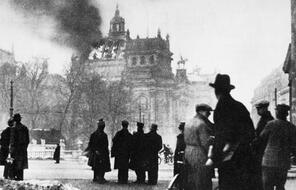Bielski Brothers’ Biography
At a Glance
Language
English — USSubject
- History
- The Holocaust
- Human & Civil Rights
Tuvia, Asael, Zus, and Aron Bielski were four of 12 children born to a miller and his wife in the rural village of Stankevich, near Novogrudok. The only Jews in a small community, they had connections within and outside of the Jewish community and quickly learned how to look after themselves. Before long, the older brothers developed a fearsome reputation. The United States Holocaust Memorial Museum’s Holocaust Encyclopedia describes how Hitler’s plans for Eastern Europe disrupted life for the Bielskis and their Jewish neighbors in Belarus:
Following the German invasion of the Soviet Union on June 22, 1941, the Germans occupied Western Belorussia (before 1939 Western Belorussia had been a part of Poland; after Germany invaded Poland in 1939 it was annexed to the Soviet Union by previous agreement with Germany). There, German authorities killed tens of thousands of Jews in Nowogrodek (Novogrudok) District (including the cities of Lida and Nowogrodek) between July 1941 and the end of spring 1942, and confined those they did not shoot to ghettos throughout the District. When German SS and police units liquidated these ghettos in 1942–1943, they killed most of the remaining inhabitants.
The brothers sought refuge in the woods where they had spent time as children. Asael and Zus, who were hiding together, set about finding safe homes for a dozen or so of their surviving relatives, including their youngest brother, Aron. Tuvia, who had been protected farther to the north—along with a few family members—by non-Jews, soon joined his brothers. In the spring of 1942, the brothers, under Tuvia’s leadership, decided to gather 30 surviving family members and a few friends. With the help of non-Jewish friends, they began to collect guns to protect themselves.
As the persecution of Jews in Belarus increased, the group faced a dilemma: should they continue to live as a tight-knit group, or were they obligated to shelter other Jews? Tuvia insisted, “I would rather save one old Jewish woman than kill 10 Nazi soldiers.” Asael and Zus initially opposed the plan, thinking that it was best to keep the unit small and manageable. In the end, Tuvia won the argument, making it clear that they couldn’t sit idle while their people were being slaughtered. By the autumn of 1942, the Bielski group had grown to include nearly 100 members.
While the Bielskis’ principal focus was saving the lives of fellow Jews, the brothers moved quickly to build a fighting force to strike back against the Nazis and their supporters. The strength and reputation of the brothers’ unit—formed as a military outfit, with Tuvia as commander, Asael as deputy, and Zus as chief of reconnaissance—grew throughout late 1942. The young fighting men, a minority of the overall Bielski group population, spent long nights obtaining food from local peasants—sometimes stealing it—in order to feed the group. They also sought out and executed Nazi collaborators, including one man who lived in the Bielskis’ boyhood village and was once close to the family. The brothers believed that the group needed to be feared if it had any chance of surviving in such a hostile environment.
As the size of the unit increased, seemingly with every passing day, the brothers sought better protection from the harsh winter weather. They organized the construction of large wooden living quarters known as zemlyankas in Russian. Dug into the ground, the structures utilized earthen walls to contain as much heat as possible. The brothers were soon watching over nearly 800 Jews, constantly moving the ragged band to new locations to keep one step ahead of the Nazis. In the summer of 1943, the camp was attacked by German forces and the entire group had to escape deep into the forest. Surviving the attack, the brothers relocated to a new spot in the dense forest and began work on a new camp.
Completed in October and November 1943, the new camp, known as Jerusalem, soon became a real village in the forest. Jerusalem had a large kitchen, a bathhouse, a blacksmith forge, a small horse-powered mill, a bakery, a tailor shop staffed by 18 men, a school for some 60 children, a gunsmith shop, a synagogue, and even a jail.
For the inhabitants of the forest camp, Tuvia was a respected and beloved figure. He frequently gave speeches before the entire assembly, often breaking down in tears at the fate of the Jews. Zus and Asael were more interested in leading military expeditions, often with the cooperation of local Soviet partisans, against the Germans and their allies. In July 1944, the Red Army arrived to officially liberate the woods where the Bielski camp was located. According to the United States Holocaust Memorial Museum, “At the time of liberation, the Bielski group had reached its peak of 1,230 people. More than 70% were women, elderly persons, and children, who otherwise would have perished under the German occupation.” Having such a diverse group living in a partisan camp was highly unusual; typically partisan encampments were limited to those fighting the Nazis.
Living in Soviet-held territory, Asael Bielski was conscripted into the Red Army and was tragically killed in battle in February 1945. Tuvia, Zus, and Aron emigrated to Palestine, where they fought in Israel’s War of Independence. The brothers later immigrated to the United States. Aron, the youngest, ran a taxi business in New York. Zus, who died in 1995, operated a trucking and taxi company, while Tuvia, the commander, toiled behind the wheel of a delivery truck. When he died in 1987, he was buried on Long Island. A year later, he was exhumed and given a state funeral with military honors in Israel.
Adapted from “Tuvia Bielski: Rescue is Resistance” Study Guide at Jewish Partisan Educational Foundation
How to Cite This Reading
Facing History & Ourselves, "Bielski Brothers’ Biography," last updated May 12, 2020.








